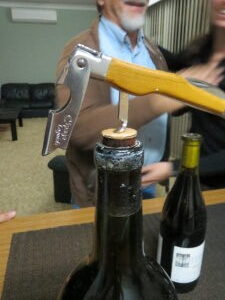After quitting my job in 2009, I became that guy that wanted to chase the perfect glass of wine. Since that time I was in and out of wineries and cellar doors, reading books and completing courses with the best trainers and drinkers in the country. I learnt very fast that this is an evolving and exciting game. The more that I learnt, the more I realised that I did not know. This drove me to gain as much knowledge and as many drinking hours as humanly possible.
This lead to a lot of great relationships and a lot of word of mouth referrals. I had the opportunity to see people that had cellared the rare and hard to find items and they were looking to sell out off their inventory of wine. In short they were willing to pass them to a good home of a younger lover, me.
I have created a set criteria to test and eliminate as many issues as possible outside the obvious TCA (2,4,6- trichloroanisole, read a great article about this here) or otherwise known as the infamous cork taint. This includes the following:
-cellar inspection, preferably on a stinking hot day
-checking for UV or naturally leaking light
-checking the actual temperature and humidity with in the cellar
-if electric; the redundancy plan
-if manufactured; refrigerant leaking points
-testing at least one or more bottles from the middle of the cellar
-a general inspection of the ullage (the level of the wine that has leaked in relation to its age and size)
-a general inspection of the screw cap (if not on cork, checks for dents and the likes)
-a general inspection of the way the bottles were stored and maintained over their life
-I also do a quick cheeky eyeball evaluation of the stock to see what my clients stocks net worth is and how it is looked after

From the above 10 points I can gain a grasp to what standards or level of quality the wines generally will be and 98% of the time I am correct. Please note there has been an odd occasion where one person moved stock from their out door tin roofed shed to a new grand indoor near perfect cellar. They tried to sell me a large quantity of their portfolio and when I asked to try a bottle the client baulked at me, but opened a bottle in the end, and no guesses what was wrong here. The bottle had expired by heat and I could see it as the cork was pulled out (there are tell tail signs for those who are experienced in the industry to know) and upon smelling I could confirm and then the taste (which was simply a waste of my time at that stage) was simply like it was a real poor off port and I had to inform them that their wine had turned. I asked to try another (just incase), totally different wine and far younger, and again similar symptoms so I asked about the cellar and how old it was, I was made were it was relatively new (and I could tell that by the air-conditioning unit) and was then informed of the outback shed was the old storage home. Needless to say the wines did not become a part of my portfolio.
It took me years and years to be able to learn and asses wines and like my mentors say “I am still learning, every year the season change, therefore the wines change.” Intern I keep learning and meeting people and drinking and acquiring more wines.

This is a cork that was opened at the 50 year mark. Its a perfect example of how wine moves up the cork over time


[…] How I do it […]